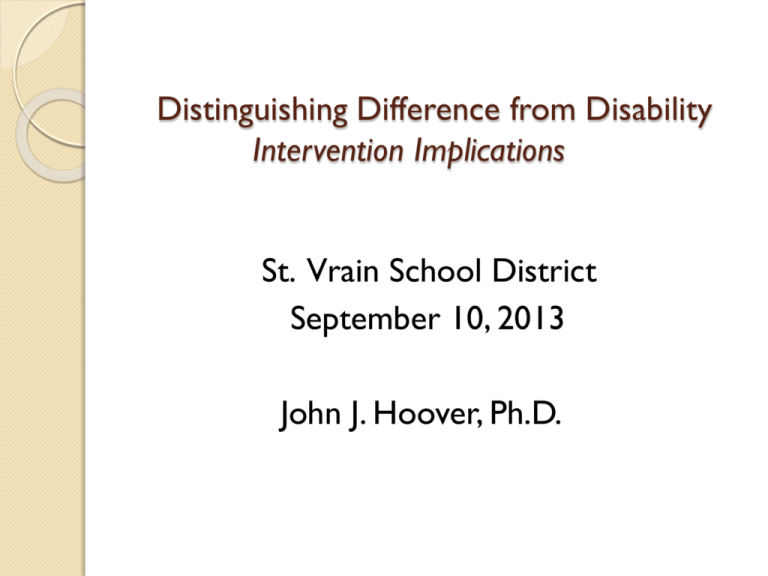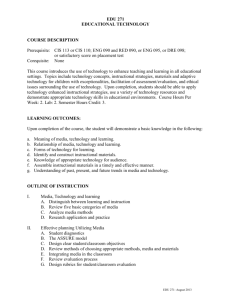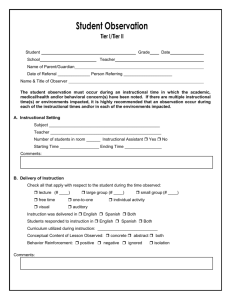Distinguishing Diff. from Disab – Interv Implications
advertisement

Distinguishing Difference from Disability Intervention Implications St. Vrain School District September 10, 2013 John J. Hoover, Ph.D. Workshop Topics I. Brief Review of Difference/Disability (Last Semester’s Session) II. Overview of Intervention (Types/Defined/ Success in RTI models/Delivery) III. Intervention Practices IV. Core Practices Instructional Tool: Action Item Workshop Outcomes 1. Recognize significance of distinguishing learning difference from disability when selecting interventions 2. Know core instructional themes necessary to deliver effective instruction and interventions for ELs 3. Recognize HOW to assist classroom teachers select appropriate interventions for ELs I. Situating Difference from Disability: Knowledge and Skills Perspective Cultural Diversity – Understand how culturally diverse teachings, values, norms influence and shape learning Learning/Emotional Disability CharacteristicsUnderstand some cultural and linguistic behaviors are similar to some disability behaviors (Must recognize differences) Three Contributing Elements to Recognize DifferenceDisability Second Language Acquisition – Understand SLA development and expected classroom behaviors Source: J. J. Hoover (2009) Distinguishing Difference from Disability: Referral, Assessment, Intervention Implications Perspective on ‘distinguishing difference from disability’ is grounded in three related research-based instructional views: 1) Funds of Knowledge (Moll, 1992) 2) Cultural influences on learning (Nieto & Bode, 2010) 3) Confusing second language acquisition with language/learning disabilities (Artiles & Ortiz, 2002) Each view toward teaching and learning highlights strengths CLD learners bring to the classroom; Behaviors that may differ from our typical expectations Historical Perspective Review: Difference-Disability Moll (1992) --- Home and community resources of students provide valuable sources of information (i.e., funds of knowledge). Artiles and Ortiz (2002) --- Behaviors associated with the normal second language acquisition process may be confused with language and/or learning disabilities (i.e., language acquisition process in learning). Nieto and Bode (2010) --- Teachers must understand the culturallyinfluenced differences students bring with them to school (i.e., cultural differences toward learning). Hoover (2012) --- Educators must acquire an understanding of the differences between cultural/linguistic and disability behaviors to make informed instructional decisions for ELs (i.e., referral, assessment, intervention decisions). Is it Second Language Acquisition, Cultural Teaching, or Disability? What students bring to the classroom may differ according to their cultural and linguistic backgrounds, individual circumstances, and teachings Differences that must not be interpreted as disabilities or deficits when selecting interventions Book: Page 16 II. Overview of Intervention Which One? Why? While one researcher may decide an intervention has enough evidence to give it high marks, another researcher, using different criteria, may give the research a lower rating (CEC Website, 2011. Evidence-Based Practice— Wanted, Needed, and Hard to Get) Term ‘Intervention’ represents two distinctly different perspectives within an RTI model Process Method Intervention as a Process Process Set of instructional procedures, tasks or schedules that frame the delivery of instruction Example-Tier 2 Tier 2 as an Intervention includes: * Small Group * Several times per week * Focus on specific area * Frequent monitoring Intervention as a Method Method Evidence-Based Specific method, strategy “instructional techniques with meaningful research support or curriculum used in that represent critical tools in the delivery of bridging the research-toinstruction in different practice gap and improving tiers or level of student outcomes” (Cook, Smith and Tankersley, in press; instruction Slavin, 2002) Intervention Example: Explicit Instruction Explicit instruction is a systematic instructional approach that includes two essential components: (a) visible delivery features with high level of teacher and student interactions, and (b) instructional design principles guiding the intervention use in the classroom (2012, NATIONAL CENTER ON ACCESSIBLE INSTRUCTIONAL MATERIALS AT CAST WEBSITE) On what basis (i.e., rationale) might one select Explicit Instruction as an intervention? Depends on the learner’s needs and strengths Intervention Rationale: Explicit Instruction Learners General Classroom Non-English Learners Usage Rationale All students benefit from well-designed, and explicitly taught skills to assist with organization, expectations, and outcomes Students with a Learning Disability Provides highly structured, interactive process addressing distractibility issues often associated with LD General Classroom English Learners Method supports structure and adequate wait time to process information; structure and time ELs require in developing proficiency with English Example: Graphic Organizers Retell, Relate, Reflect Standard Skill: Use key ideas and details to recount stories, including fables and folktales from diverse cultures, and determine their central message, lesson, or moral. Concept: Fables and folktales; Central message, lesson, moral Rationale Relating and reflecting will encourage EL students to develop thinking strategies important in acquiring skills in first and second languages. Reflecting on own culture, students actively engage with the reading focus on key details through retelling, also important in acquiring English and skills in English http://www.readingquest.org/strat/story maps.html http://www.readingaz.com/comprehension/reading-graphicorganizers/ Summary: Intervention Selection Selecting Intervention as a method or as a process requires attention to learning needs and strengths to best understand WHY whatever is selected is appropriate Requires greater specificity than simple selection (e.g., Why might Explicit Instruction be best for my ELs?; Which type of Graphic Organizer would be best to use?; If I use Think Alouds which specific learner strengths or needs am I addressing?) Selecting Interventions to Make Instructional Adjustments Must select an intervention for the correct and accurate reasons (avoiding misinterpreting a difference as a disability) to make meaningful changes in ELs education and progress Interactive Check-Five Minutes Task: Turn to a colleague and share one example from your experiences that illustrates the misinterpretation of cultural and linguistic diversity in selecting or delivering an intervention (method or process) III. Intervention Practices Best Structure for Implementing Intervention “In schools we have worked with where general education teachers are assigned both Tier 1 and some Tier 2 groups, reading specialists are assigned to Tier 2 and Tier 3 groups, and special educators are assigned to Tier 3 and some Tier 2 groups, we find that a real shared responsibility perspective develops. In those schools where general education teachers are always viewed as only Tier 1 instructors, remedial teachers as Tier 2, and special educators as Tier 3, we find that breaking down the natural "mine" versus "ours" dimension of thinking about collaboration across instructional concerns is more difficult.” Source: E. S. Shapiro (RTI Action Network Website) Selected Reasons Why Interventions in Multi-Level Instruction May be Ineffective 1. Instruction in Tiers 1 and 2 is disconnected Solution: Utilizing skills and strengths of general class and support educators to clearly demonstrate interconnectedness of instruction in both tiers 2. Continued emphasis placed on what is “wrong” with learner (i.e., intrinsic) Solution: Drill down into the curriculum not into the child (i.e., How might the Tier 1 curriculum be implemented differently to best meet learner need? What aspects of the curriculum may be contributing to learner’s struggles?) 3. Instructional adjustments are made based on data yet address wrong need Solution: Directly link assessment to instruction by properly interpreting results (e.g., recognize that select ways of learning reflect cultural teachings; distinguish language acquisition from language disability; need for extra time is cultural or a second language acquisition development behavior) Source: J. J. Hoover (2012) Goldenberg 2008 Instructional modifications for ELLs Meaningful contexts Opportunities for repetition and use Explicit vocabulary instruction Cooperative learning Instructional conversations Combination of direct and interactive approaches Familiar text Scaffolds (graphic organizers, routines, redundant key info) Additional time Framing Intervention as a Culturally Responsive Process 9. Explicit, Small Group Instruction (Directed/guided in 8. low stress Promote Student situations) Controlled Classroom Discourse and Cooperative Learning (Promote reciprocal dialogue; interactions) 1. Communicate High Expectations (Respect student capabilities) Essential Instructional Components in Intervention Process 7. Provide Culturally Mediated Instruction (Actively facilitate problem solving abilities; Language connections, development) 6. Reshape the 5. Curriculum Demonstrate (Differentiate to Cultural Sensitivity meet diverse needs; (Acquire Build background cultural/linguistic knowledge) awareness of own students and incorporate in teaching) 2. Use Active Teaching Methods (Promote student active engagement) 3. Facilitate Active Learning (Balance explicit and facilitated instruction) 4. Include Parental/ Family Perspectives (Value family input and views) Sources: Callins, 2006-NCCRESt Brief); Goldenberg, 2008) IV. Core ESL Instructional Practices (CEIP) Guide Development over past 2 years Purpose: Identify and confirm common instructional practices necessary to deliver effective core Tier 1 instruction to ELs in the general classroom (Reading, Writing, Math, Social Sciences) Process: Fourth Iteration Five Cognitive Interviews Two Focus Groups One Pilot CEIP Core ESL Instructional Practices ESL Instructional Tool Research Perspectives While we know that some general education practices are effective with English Learners (EL), research is also clear that teachers must make pedagogical modifications to account for differences in language proficiency (August & Shanahan, 2006; Goldenberg, 2008). Unfortunately, we have data to suggest that many general education teachers are unprepared to institute these modifications. A recent report contained the following conclusion about teacher preparation: “Less than 13 percent of teachers have received professional development on teaching ELLs” (NCTE, 2008, p. 6). Handout: Two-Column Themes CEIP Pilot Responses Mean pilot scores for each theme (n=35) Theme 1-Connections 2-Materials 3-Native language Usage 4-Culture 5-Differentiations 6-English language Dev. 7-Assessment for instruction Average Level 3.48 Frequent-Extensive 3.07 Frequent 1.97 Minimal-Partial 2.85 Partial-Frequent 3.36 Frequent 3.32 Frequent 2.97 Partial-Frequent 4=Extensive - Practice is employed throughout all lessons in the entire unit 3=Frequent - Practice is employed throughout most lessons in the unit (i.e., more than half) 2=Partial - Practice is employed in a few lessons in the unit (i.e., more than 1 or 2; less that half) 1=Minimal - Practice is never or infrequently employed in the Unit (i.e., in only 1 or 2 lessons) Source: J. J. Hoover et al. (2013). Core ESL Instructional Practices (CEIP) Guide: Self-Examination and Instructional Coaching Tool. Practitioner Usefulness 1: Self-Examination – Respondents reported the CEIP useful in guiding self-assessment and many asked for a copy of the tool, indicating they wished they had this tool to help them in their classroom teaching. 2: Use with Instructional Coaching – Similar to the above item participants indicated that the CEIP would be highly useful in their coaching/mentoring instructional activities for both the coach and teachers receiving support. 3: Design Professional Development – Respondents stated that the CEIP would be good for designing school-wide professional development with several indicating that gradelevel teams would find this very helpful to determine ESL knowledge and skills requiring additional development. Sample Theme Completion Based on your current/recent teaching or your knowledge of instruction in classrooms you supervise/support, complete the following three Themes on the CEIP: Connections Differentiations Assessment to Inform Instruction Items on Page 9 Task for September 19th Session Select three general education classroom teachers who have ELs in their classrooms and have them complete the CEIP. Bring completed guides to the 19th session Familiarize yourself with your three completed guides, especially the Action Items identified by the teachers






